Marketing roadmaps help you plan complex strategies by scheduling marketing activities in a set timeframe. Today’s marketing teams have to manage campaigns across multiple channels with a mix of short-term and long-term projects, each with its own goals and objectives.
A detailed roadmap organises all of your marketing activities and pulls everything together to ensure your daily workloads are building toward your long-term goals. So, in this guide, we explain everything you need to know about marketing roadmaps and how to build them effectively in nine easy steps.
What are we looking at in this article?
This article is designed to be a one-stop guide to everything you need to know about marketing roadmaps, including a step-by-step guide for building them effectively. To cover everything we need to look at, we’ve broken this up into the following sections:
- What is a marketing roadmap? A quick definition to explain exactly what we’re talking about in this article.
- Why are they important? A summary of the key reasons marketing roadmaps are so important.
- What should a roadmap include? A list of the key elements to include in your roadmaps.
- Marketing roadmap types: A quick look at some of the most common types of roadmaps.
- How to build your next roadmap: A step-by-step guide for building marketing roadmaps effectively.
You can click on the blue link text above to jump ahead to any given section and you may also want to bookmark this article so you can come back to it when you sit down to create your next roadmap.
What is a marketing roadmap?
A marketing roadmap lays out the timeline and activities of a marketing strategy, campaign or project. It pulls all of your marketing efforts into a coordinated plan where every action has a start date, end date and objective with each action contributing towards the end goal.
A basic linear roadmap could simply involve a series of tasks scheduled in a spreadsheet on specific dates – something like the following:
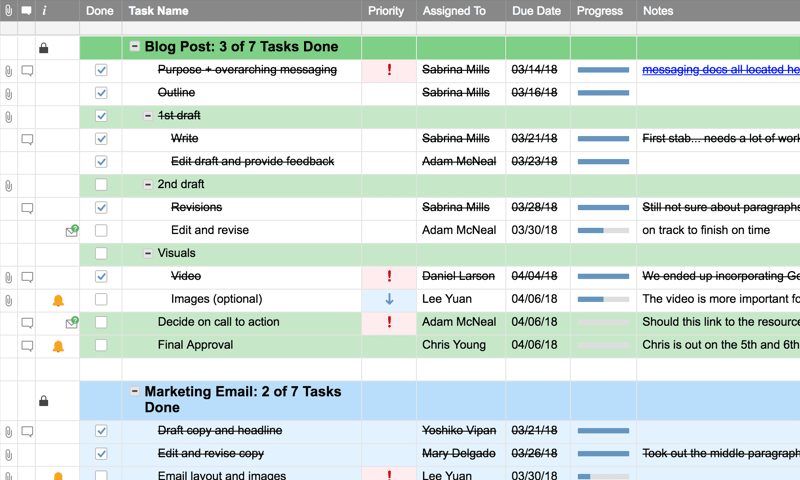
However, most marketing projects involve multiple channels and require different teams or personnel to come together and work on a series of tasks that all contribute towards completing the primary goal(s).
This requires a more sophisticated type of marketing roadmap that allows you to visually schedule tasks, organise them by type, assign tasks to teams or individuals and map out your strategy from start to finish. Managing roadmaps like these on spreadsheets is pretty cumbersome but there are plenty of drag-and-drop tools that help you quickly map out schedules to your time frame, assign tasks with a couple of clicks and make changes on the fly.
In fact, Laura Sima explains how you can plan a campaign roadmap using Toggl on the company’s blog page.
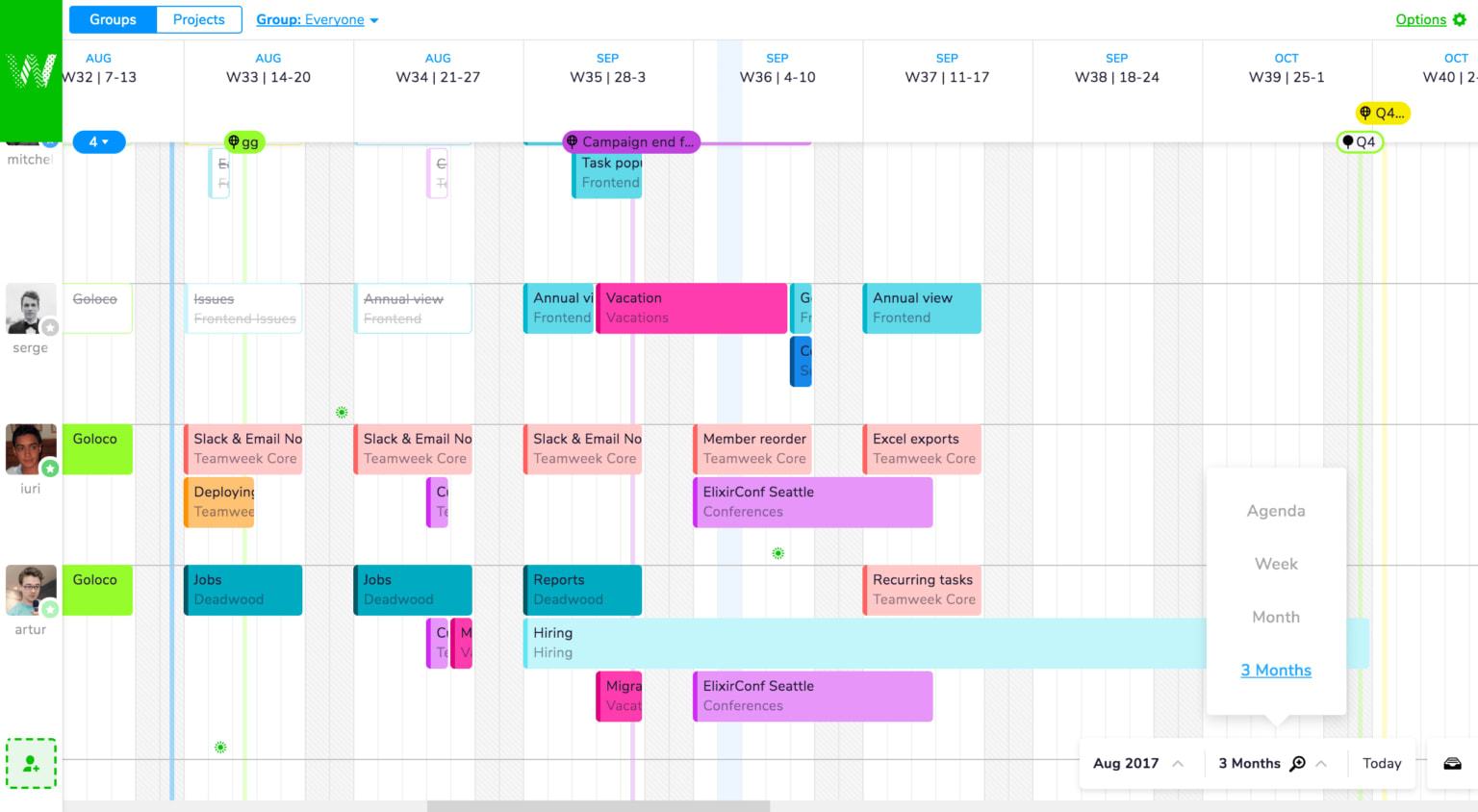
This more visual approach to developing roadmaps makes it easier to manage the workloads of team members and ensure every task is given enough time to complete their objective and keep things moving towards the project goal.
You don’t need this kind of software to create marketing roadmaps – you can use Excel, Google Sheets or any other spreadsheet software and the only real downside is it takes longer to create and edit your roadmaps. It’s also more difficult to visualise workloads and move things around to create a schedule that fits everything in.
So we’re talking about issues of convenience more than necessity.
Another benefit of using project management software to build your marketing roadmaps is many of them include pre-made templates that you can use to create a variety of roadmaps faster. As with most things of this nature, the more often you’re creating marketing roadmaps, the more you’ll benefit from specialist software and this is especially true for agile marketing teams that need to plan and deploy new campaigns quickly.
If you’re interested in this kind of tool, we’ve reviewed five of the best marketing management software – all of which are capable tools for creating roadmaps.
Why are marketing roadmaps important?
Marketing roadmaps are primarily a planning tool but they’re important for a variety of reasons. The more complete your marketing strategies are, or the faster your marketing team needs to move, the more benefits you’ll gain from building marketing roadmaps on a regular basis.
This is the case for most companies these days, which need to integrate multichannel strategies with a mix of short-term, long-term and ongoing campaigns.
Marketing roadmaps organise this complexity by creating a schedule and workload that aligns your marketing activities and keeps everything moving towards completing your goals.
- Goal completion: With a planned schedule and fixed workloads, every marketing action works towards completing goals.
- Milestones: Creating roadmaps helps you set achievable objectives
- Organisation: Roadmaps allow you to plan, organise and arrange all of your marketing activities into a schedule that’ll achieve your goals on time.
- Task management: Assigning specific marketing actions to teams and individuals.
- Resource management: A roadmap allows you to ensure resources are always available when needed.
- Time management: Strict start and end dates keep everyone on schedule.
- Alignment: Everyone on your team knows what they’re working on and what they’re working towards.
- Visibility: Team members and stakeholders can see how your marketing actions are building up to goal completions.
- Coordination: A good roadmap brings teams, strategies and campaigns into a single, organised strategy.
- Accountability: Roadmaps holds teams and individuals accountable for thier successes and failures.
- Reporting: An organised marketing schedule gives your reporting more contextual meaning, especially on long-term projects or strategies.
I’m not saying that’s a complete list of all the reasons to create marketing roadmaps but there’s enough there to convey why they’re so important. Marketing roadmaps organise the chaos of modern marketing and guide your team through every stage of each campaign, ensuring they can make an impact with every marketing action.
What should a marketing roadmap include?
There are many different types of marketing roadmaps (we’ll look at the most common ones in the next section) and each of these can include slightly different elements. However, every marketing roadmap should include the following core elements:
- Clear goals: You should have a specific goal to complete at the end of your roadmap while multiple campaigns and projects within the roadmap itself will have their own goals.
- Milestones: Specific targets you need to hit throughout your roadmap to complete your primiary goal.
- Organised tasks: Your roadmap should organise every marketing activity planned for the complete strategy, campaign or project.
- Start dates: Each task should have a specific start date.
- Deadlines: Each date should have a fixed deadline.
- Durations: Every marketing action should include a duration – whether it’s hours, days, weeks or more.
- Assigned roles: Every team member are assigned a specific role.
- Assigned tasks: Every task is assigned to the correct team or individual.
- Assigned resources: Resources required for each marketing action is assigned to ensure availability.
- Task statuses: Task statuses are updated as the strategy, campaign or project runs.
- A schedule: Every marketing activity is scheduled out to ensure your goal is achieved on time.
Whichever type of marketing roadmap you’re creating and however you choose to build/visualise it, every roadmap should include the 11 elements listed above. By including these core essentials in every roadmap, you’re planning out the foundations of a coordinated marketing strategy and you can bring order to the most complex mix of marketing actions.
The different types of marketing roadmaps
Now that we’ve covered the essential ingredients of marketing roadmaps, we can start to discuss some of the different types of roadmaps you’ll commonly want to create. The first three types to talk about are designed for planning and managing marketing activities at three different levels: strategies, campaigns and projects.
At the top level, you have marketing strategies, which contain multiple campaigns that contain multiple projects.
Another common type of roadmap for all business types is channel-specific so you might have separate roadmaps for SEO, PPC, social media and every other channel. Finally, we’ve got a couple of roadmaps most commonly used by companies promoting digital products, such as SaaS marketing teams: product roadmaps and portfolio roadmaps.
Here’s a quick summary of the roadmaps we’re about to look at in more detail:
- Strategy roadmap: The top-tier roadmaps organising all of your marketing campaigns, projects and tasks.
- Campaign roadmap: Specifically map out the projects and marketing activities for individual campaigns.
- Project roadmap: Map out the tasks and activities for individual marketing projects.
- Channel roadmap: Plans for individual marketing channels – eg: SEO, social, email marketing, etc.
- Product roadmap: Map out a marketing strategy in conjunction with product development, release and/or promotion.
- Portfolio roadmap: A high-level overview of marketing strategies across a portfolio of multiple products.
As we take a closer look at these roadmap types, you’ll see why it’s advisable to create most or all of them on a regular basis. For long-term strategies and campaigns, you’ll spend more time managing and updating existing roadmaps but shorter marketing runs (eg: sprints) will require you to create detailed roadmaps regularly and quickly.
Strategy roadmap
A strategy roadmap is the top-level plan for all of your marketing activities within a complete, multichannel strategy. Most commonly, companies will create a strategy roadmap for each year although many companies revise their roadmaps quarterly, which is a good idea if performance naturally fluctuates or results are heavily affected by external marketing events – eg: weather patterns, economic trends, etc.
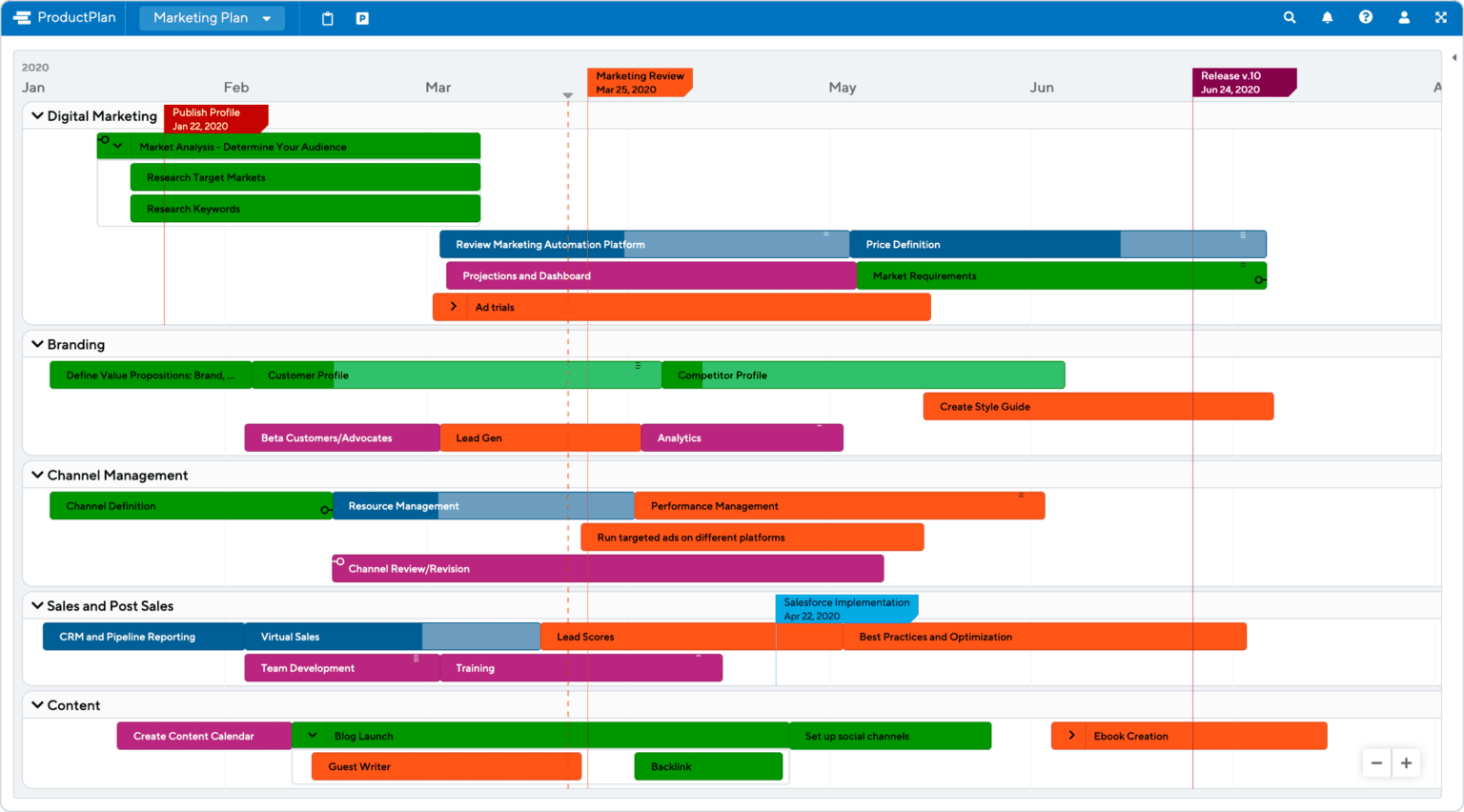
Your strategic roadmap should include the schedules for all campaigns and projects but you don’t have to plan the full year’s worth of marketing activity ahead of time. More likely, you’ll be planning ahead for quarters although agile marketing teams will often add campaign schedules on a monthly or weekly basis.
So, if you’re creating a strategy roadmap for the year ahead, you may set out to plan all of the marketing activities for Q1 and start planning for Q2 a month in advance, based on how results are going – whatever works for you.
What’s more important is that, when you create your strategy roadmap, you set a specific goal to achieve upon completion. So, again, if you’re creating a roadmap for the next year, you might set the goal of increasing revenue by +30% by the end of Q4. Next, you can use this goal to set milestones for each quarter so you might set preliminary targets of increasing revenue by 7.5% (from the previous year’s total) in each quarter and you can always adapt these targets based on the performance of the previous quarter.
Campaign roadmap
At the campaign level, you can set more specific goals and short-term targets to achieve the goal of your annual strategy. Some campaigns may run for the full year while others run for several months or weeks, working towards your primary goal for the end of the year.
If we stick with the annual goal of increasing revenue by +30%, you might set the following campaign goals as milestones:
- Increase customer retention by 4% by the end of Q4 (1% each quarter)
- Increase positive reviews by 10% by end of Q2
- Lift conversion rates by 2.5% by end of Q2
- Increase onboarding completions by 5% by end of Q2
- Lift traffic by 12% by end of Q1
So, we’ve got five campaign goals above with specific targets and deadline dates. The first campaign goal is an ongoing campaign of improving customer retention across the whole year with quarterly targets that can be reviewed based on performance. Then, you’ve got three targets for the end of Q2 and these deadlines are set because you need to hit these targets in order to achieve your revenue goal for the end of the year – after all, you need time to benefit from the 2.5+% increase in conversions.
Finally, we’ve got a 12% increase in traffic set for the end of Q1, which will increase the volume of leads you have to work with through quarters 2-4.
Each campaign should have its own roadmap, planning out all of the marketing actions involved and assigning tasks to each team member. Creating roadmaps for each campaign is a great way to clarify the goal and focus on completing it without getting distracted by other aspects of your marketing strategy.
These roadmaps are also important references for marketing teams, providing a clear schedule for the campaign their working on the tasks they need to complete each day.
Project roadmap
Campaigns are built up from multiple projects, which refers to any marketing activity that has a process – for example, creating a blog post, setting up a new ad group or running an A/B test. So, let’s say you’re running a content marketing campaign to increase traffic in Q1 and you’ve come up with a plan to create 24 blog posts, 12 newsletters and four downloadable resources.
In this case, it makes sense to create three project roadmaps to suit the different processes involved in creating blog posts, newsletters and downloadable content.
For example, your project roadmap for creating 24 blog posts by the end of Q1 may involve the following:
- Research: Keyword research, analysis of existing content, competitor analysis and other research methods.
- Topics: Based on research, developing a list of key topics around keywords and potential title ideas.
- Titles: A collaborative session where team members come up with title ideas and select the best contenders.
- Content calendar: The schedule for publishing each chosen title on specific dates and assigning each blog post to team members.
- Production: Each team member creates their assigned blog posts a week ahead of publishing date.
- Editorial: Each post is proofread, optimised and checked ready for publishing.
- Analysis: Posts are tracked to measure performance, based on the goal of increasing traffic.
- Revision: Underperforming posts are updated/optimised and the content strategy is revised at the end of each month, based on performance (eg: removing certain topics that aren’t gaining traction.
You could even break the steps above into separate project roadmaps – one for the planning stage outlined in the first four steps and another for the production of each individual blog post. At this point, creating processes for every post could create unnecessary work if the process for creating posts is always the same or very similar.
However, if different types of blog posts involve different marketing actions – such as custom images, video clips, interviews, etc. – then you may need to schedule these actions out to ensure each task is assigned to the right person and the required funds, time and resources are all available.
Channel roadmap
The first three roadmap types we’ve looked at cover the three tiers of a multichannel marketing workload: the strategy level, campaign level and project level. However, it’s also useful to plan and view workloads of individual channels. This allows departmental teams (SEO, PPC, social, etc.) to view their schedules independently from anything else and it can also help with managing the availability of personnel and resources.
Planning out channel-specific actions is also important for demonstrating the work that goes into the relevant activities so you can set schedules more accurately and budget accordingly – good for teams and stakeholders.
The key is to create your strategy, camping and project roadmaps first so you can pull in the information from their schedules to create your channel-specific roadmaps. This way, you’ve already got the tasks, start dates, deadlines and all the other information that you need – all of which is working towards completing your goals.
Basically, think of the channel roadmap as a filtered view of your other roadmaps that filters out all of the marketing tasks relevant to other channels. Ideally, you’ll have a roadmap software tool that makes it easy to filter out this information and view channel-specific roadmaps.
Product roadmap
Product roadmaps are typical for SaaS companies and other businesses selling digital goods. Every product requires a marketing roadmap covering the following stages of the product lifecycle:
- Planning
- Design & development
- Launch
- Growth
- Maturity
- Decline
Obviously, the roadmap for marketing teams differs from the roadmap for designers and developers throughout these six stages but there are important overlaps. For example, if we’re talking about a software product, market research should inform the features included, the design conventions and differentiations vs existing software products (if they exist).
During the launch and growth stages of the product lifecycle, marketing efforts focus on promoting the product itself and maximising purchases while the emphasis shifts towards optimisation in the maturity stage and maximising longevity through customer retention, new features and perhaps more drastic strategies, such as a rebranding effort.
At this level, the product roadmap spans several years (or so you hope) and, potentially, even longer. And, much like the top-level strategy roadmap we discussed earlier, you’ll also want to create roadmaps with this for specific marketing campaigns and projects.
Portfolio roadmap
While a product roadmap is focused around a single product, portfolio roadmaps set out a plan for a portfolio of multiple products. For example, a company like HubSpot sells five different software products so it needs to plan out a coordinated marketing strategy that prioritises and promotes each product accordingly.
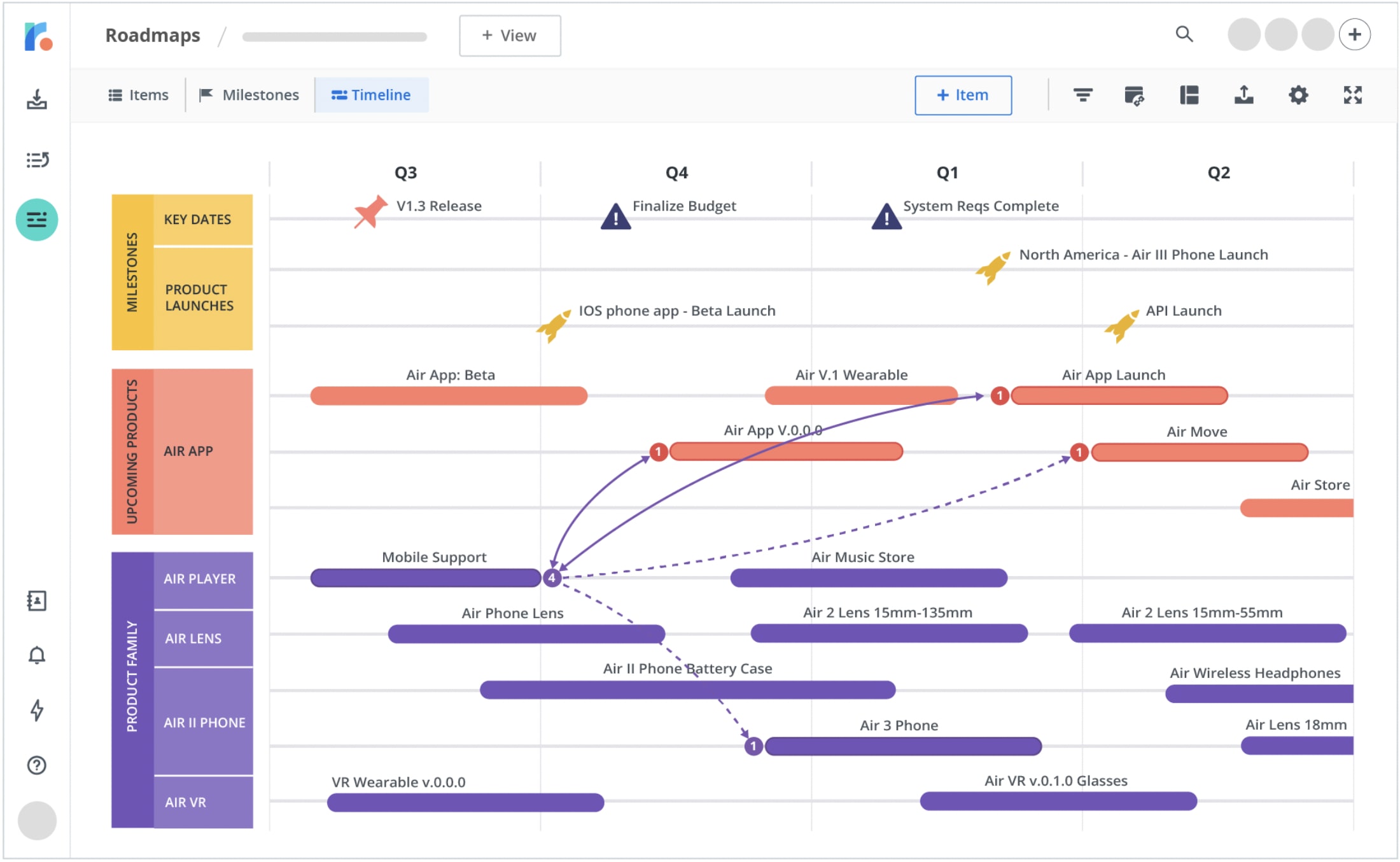
Again, this is typical of SaaS companies but the same is true for any business that produces and markets a small range of its own products.
How to create your next marketing roadmap in 9 steps
Now that we’ve covered all of the background information we need to talk about in regards to marketing roadmaps, we’re finally ready to look at our step-by-step guide for creating your next roadmap.
We’ve broken this down into the following nine steps:
- Decide what you’re planning: Are you planning next year’s marketing strategy, a campaign roadmpa or something else?
- Set your goals: Start with the goal you wish to achieve at the end of your plan and, then, any intermediary goals (eg: Q1, Q2, etc.).
- Set your milestones: Break your goals down into milestones and objectives that’ll keep you on track for goal completion.
- Ideation: Get your team to come up with strategy and campaign ideas to achieve the goals and objectives you’ve set.
- Develop & prioritise: Develop your best ideas and prioritise marketing activities in order of expected impact vs input.
- Map out your marketing activities: Visually map out your marketing activities with start and end dates while setting hard deadlines for objectives anf goal completions.
- Assign tasks & resources: Set out the workload of teams and individuals along the timeline in your roadmap.
- Revise your roadmap: Ensure your roadmap is realistic and that your goals are achievable upon deadlines with the personal, resources and schedule you’ve created.
- Stick to the roadmap: Your roadmap includes hard deadlines, specific targets and detailed timelines – so stick to it!
By following the nine steps above, you’ll ensure every marketing roadmap includes all of the key elements required.
Step #1: Decide what you’re planning
The first step for creating a new roadmap is to specify exactly what you’re planning. Earlier, we looked at some of the most common types of roadmaps marketing teams create and here’s a revised list with some other examples:
- Strategy roadmap
- Campaign roadmap
- Project roadmap
- SEO roadmap
- Content marketing roadmap
- Email marketing roadmap
- Product development roadmap
- Portfolio roadmap
- CRO campaign roadmap
- Customer retention roadmap
- Website redesign roadmap
You can create roadmaps for pretty much any marketing activity that involves multiple steps and/or personnel. At the top level, you’re creating a strategy roadmap for all of your marketing efforts (probably for the next quarter or year) but every campaign, project, channel and project requires a roadmap of its own.
Any time you sit down and plan out a process for some kind of marketing activity, the first thing you should do is set out a roadmap. This sounds like a lot of work when we’re looking at a list of examples but a good roadmap will improve the results of all your marketing activities and each one you create provides a template to follow for similar marketing processes in the future.
Step #2: Set your goals
Once you know exactly what you’re planning in your next roadmap, you can start to set your goals. You’re not just plucking ideas out of the air or coming up with arbitrary targets, though. Your goals should be informed by targets set from above, whether this means the business goal of the company or the primary goal of your marketing strategy.
Earlier, when we looked at the top-level strategy roadmap, we discussed an annual marketing goal of increasing revenue by +30% by the end of Q4. We then explained how you might provisionally set quarterly goals of +7.5% revenue increases for each quarter, which would be revised throughout the year, based on the performance of the previous quarter.
Then, we talked about campaign roadmaps with a series of potential campaign goals – all of which were derived from the primary marketing goal of increasing revenue by +30%:
- Increase customer retention by 4% by the end of Q4 (1% each quarter)
- Increase positive reviews by 10% by end of Q2
- Lift conversion rates by 2.5% by end of Q2
- Increase onbaording completions by 5% by end of Q2
- Lift traffic by 12% by end of Q1
These are the campaign goals you identify as the objectives you need to achieve in order to meet your primary strategy goal by the end of the year.
This is the approach you should take to setting goals at each level of your marketing planning. It’s important that you don’t get distracted by setting roadmap goals that could pull you away from your primary marketing goals and potentially waste resources that could be better spent elsewhere.
The good news is, creating roadmaps for every level of your marketing activities is a great way to constantly confirm that you’re keeping your eyes on the long-term goal, even when you have to plan for short-term success, too.
If you need more help with setting marketing goals, in general, take a look at our ultimate guide to marketing strategy, which has a full section on setting goals properly.
Step #3: Set your milestones
Once you’ve set the primary goal(s) for your next roadmap, it’s time to set the milestones you need to hit at key deadlines along the way. We already touched on this in the previous section with the goal of increasing revenue by +30% by the end of Q4 and, then, setting preliminary milestones of increasing revenue by +7.5% in each quarter.
By setting milestones at key dates, you set targets that build towards goal completions. Crucially, you can use milestones to track performance and check whether you’re on course to complete your goals at key intervals. So, if we stick with the example of increasing revenue by +30% and having quarterly milestones of +7.5%, you can track performance in Q1 against the milestone of +7.5% and take reasonable action early instead of waiting until the end of Q3 to realise you’re not going to hit your +30% target.
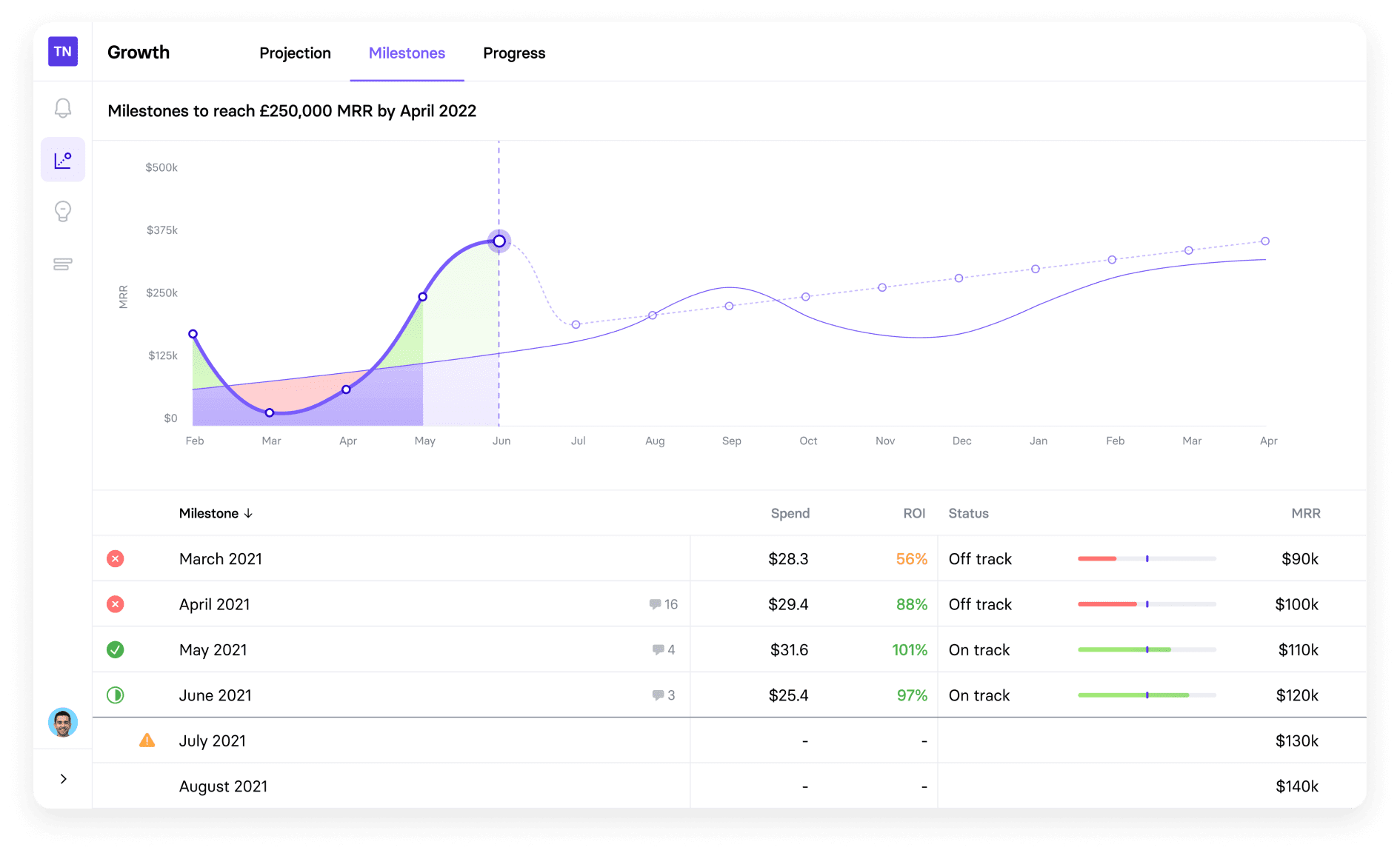
Obviously, you have to expect early performance in Q1 to be sluggish but you can set the provisional target of increasing revenue by ~3% at the halfway mark of the first quarter. Even if you’re short of hitting this target, you still have plenty of time to lift performance and get close to that 7.5% milestone for Q1, which would be a big achievement for the first quarter if revenue isn’t normally higher than usual in Q1.
You can also reassess your milestones as the strategy, campaign or project progresses. So, let’s say you hit your +7.5% milestone for Q1, then you might determine that you can achieve an even higher revenue increase by the end of Q4 and revise your strategy goal. Likewise, if you fall reasonably short of any milestone, you know that you need to pick performance up in the next period to get back on track for achieving your primary goal.
Step #4: Put your marketing ideas together
With the goals and milestones set out for your next roadmap, you’re ready to plan out the marketing actions that will hit your targets at every step. This is a collaborative process and you want to start inviting team members to contribute ideas that you can compile and refine. For most marketing teams, this process starts in group ideation meetings but we’ve found this process a little inefficient here at Venture Harbour.
The better approach for us has been to digitally invite team members to submit ideas individually by sending them the goals, milestones and timeframes of the roadmap and giving them time to come up with suggestions. This allows them to sit down by themselves, have a good think about how they can contribute to the next project and refine their suggestions before submitting them.
This removes any pressure to come up with ideas on the spot or feel the need to suggest the first thing that comes to mind, rather than having a real think about how to achieve the marketing goal in question.
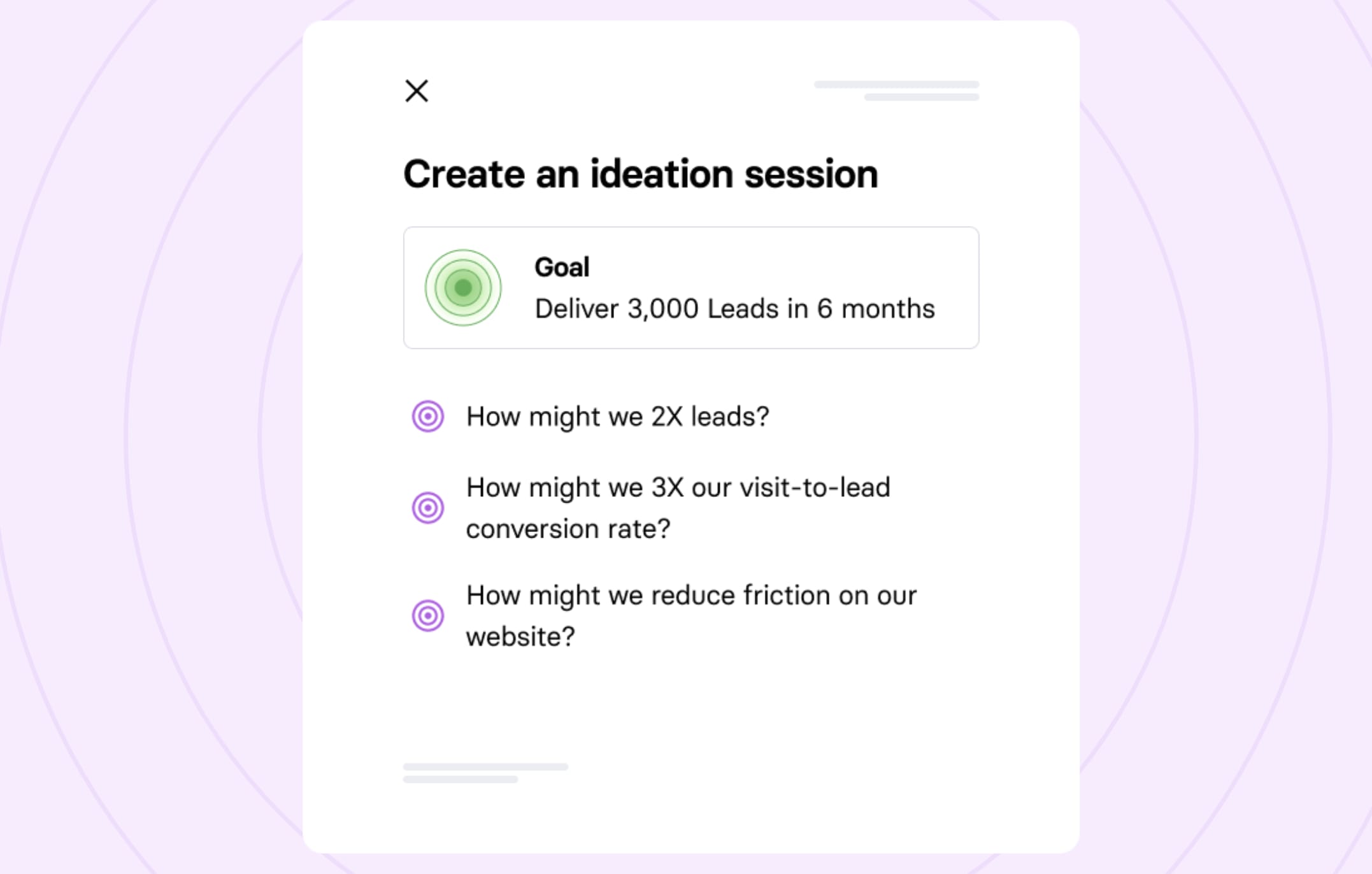
We use TrueNorth to send out requests to a list of team members who can, then, work independently or collaborate together on ideas within the software to send back a collection of suggestions. This gives the team leader or campaign manager a list of ideas to work with in the roadmap and start looking at potential schedules, based on the available budget, personnel and resources.
This approach means you can walk into the first creative meeting with a list of ideas to discuss and explore as a team. The meeting host can provide feedback on the suggestions, explaining why some of them have potential and why others may not be suitable for this particular project. As a team, you can refine your list of marketing ideas into a smaller collection of marketing actions that have real potential, which you can develop further and improve before finalising the roadmap.
Step #5: Develop & prioritise
Once you have a refined list of your best marketing ideas, you want a system in place for developing them further and laying out the specifics of how each marketing action will run. The first thing we do with campaign ideas is run them through TrueNorth’s campaign simulator to check whether they’ll achieve our goals and milestones.
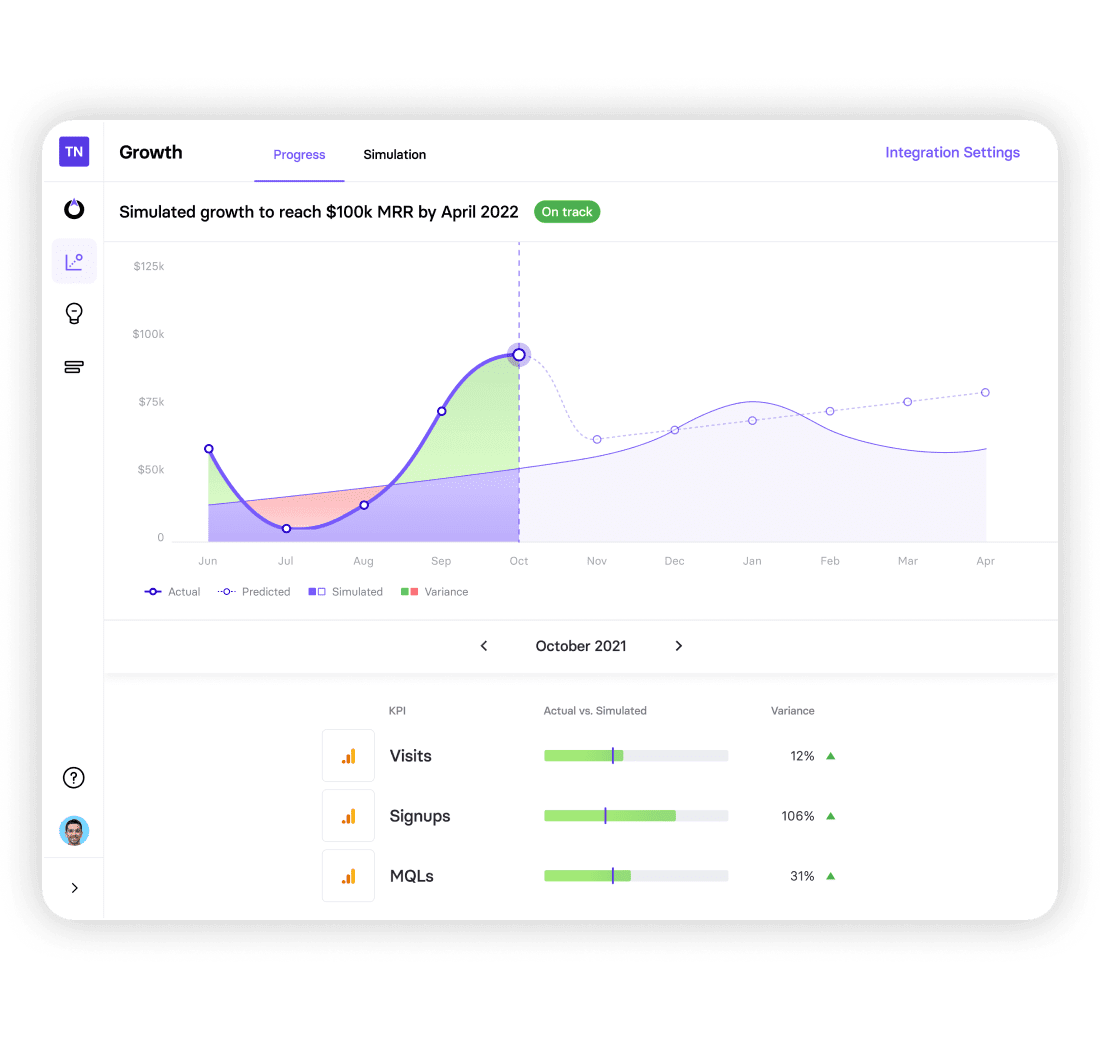
This data-driven approach to testing marketing ideas removes guesswork and intuition from our strategic planning, allowing us to choose the ideas calculated to generate the best results. We can also use the same projections to prioritise our marketing ideas based on simulation results and other factors, including expense and difficulty.
Crucially, we’ve automated as much of the ideation process as possible and enhanced our ability to prioritise our best marketing ideas with forecasting.
Step #6: Map out your marketing activities
With a prioritised list of marketing ideas, you can now map out your marketing activities in your roadmap. This is where you need to set specific start dates, durations and end dates with an understanding of the personnel and resources required to complete each marketing action.
This is where your roadmap tool really has to meet your needs, especially when you’re creating more complex roadmaps with potentially dozens, hundreds or even more marketing actions to organise.
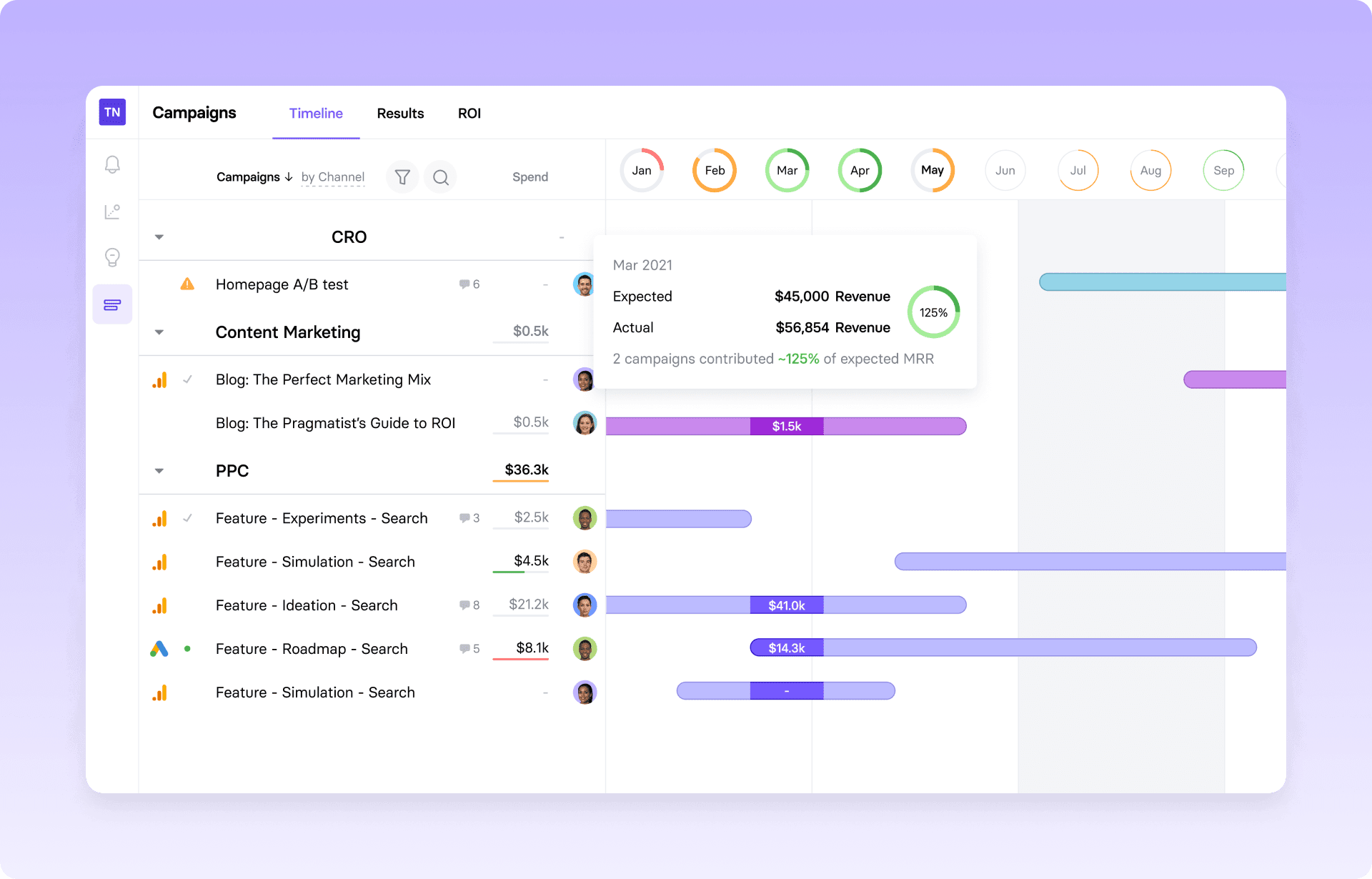
You may encounter scheduling problems as you map out your marketing activities and this is a common problem at this stage of the planning process. For example, you’ll often find the total duration of all your marketing actions adds up to more time than you have available for the entire project or certain actions need moving around to accommodate others.
You’ll also need to scrutinise your schedule to ensure there’s enough time remaining for other activities that need carrying out beyond the specifics of your strategy, campaign or project. For example, if team members have to attend meetings, fill out reports or send over more marketing ideas for another roadmap, ensure everyone has enough time to manage their workload – inside and outside of the roadmap.
Step #7: Assign tasks & resources
Building upon the point of workload management, the final task of building your marketing roadmap is to assign tasks to the right individuals and make sure the required resources are available. Your roadmap is designed to fail if you’re scheduling more work than you have the personnel to manage in your timeframe.
Also, you want to make sure the workloads of everyone on your team is enough for them to manage personally, along with everything else they’re expected to do outside of the roadmap. Burnout is a big issue for individuals but equally as damaging for the team and your prospects of achieving marketing goals.
You should also pay attention to the resources required to complete each marketing activity and ensure they’re available when needed. For example, if you have software tools with a limited number of user seats, you don’t want schedule conflicts that leave team members fighting over the same tools.
Step #8: Revise your roadmap
Before you sign off your roadmap, take the chance to revise everything in your schedule and make sure your plans are capable of achieving your goal(s) on time. Reassess your campaign goals, milestones and other targets to ensure the crucial numbers add up to success at the end of your timeline.
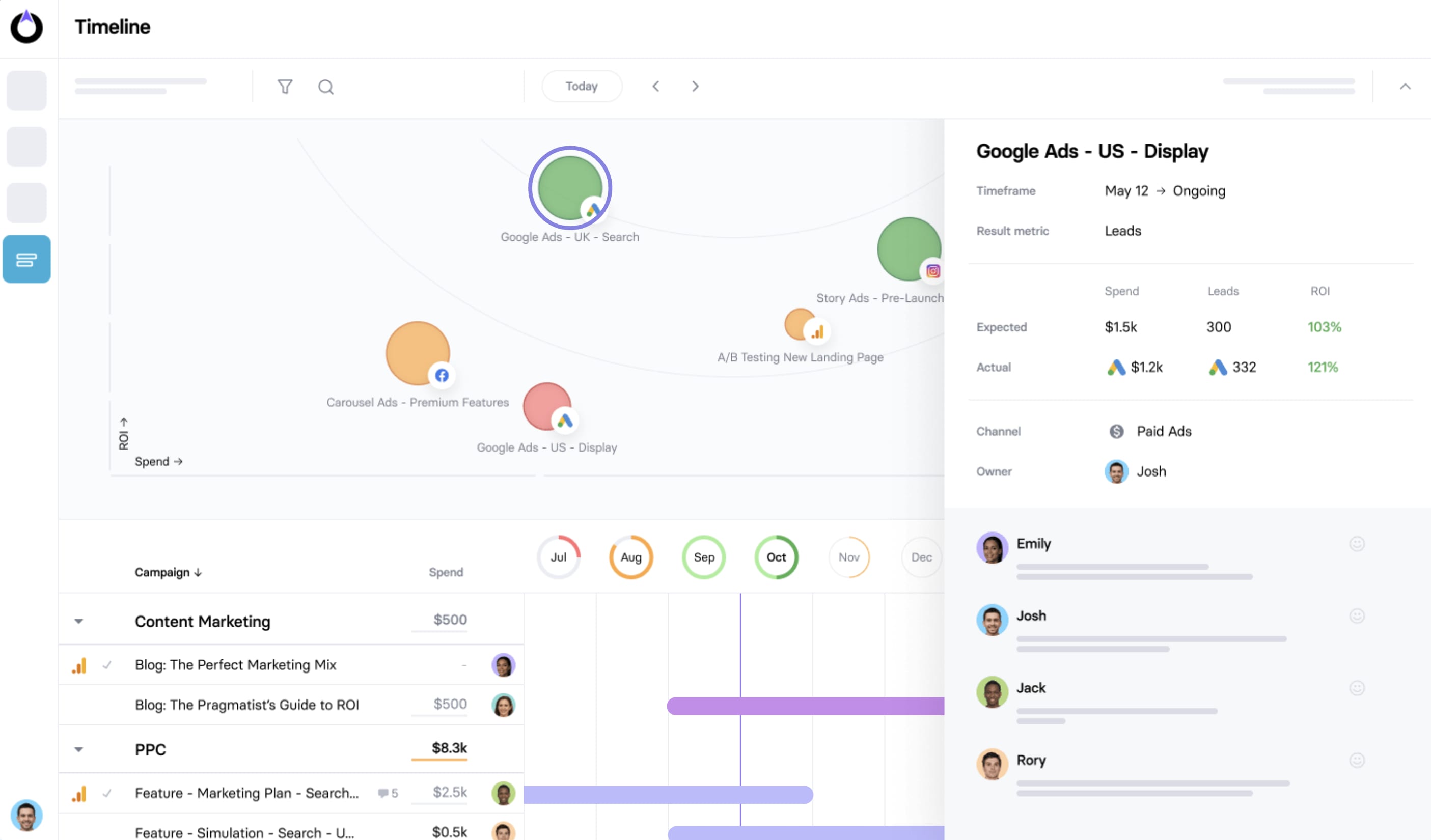
If you had to change any of the time frames to fit everything into your schedule, run your campaign simulations again to check the outcomes still leave you on track to hit your targets.
Take one last look at the workloads of teams and individual team members to make sure they have enough time to complete each marketing action.
You’ll also want to finalise budget allocation and ensure your schedule doesn’t take you over the total budget for your next project. In fact, you may want to reserve some budget for any instances where performance falls short of projections and you have to optimise your way back on target (this may require time as well as money).
Step #9: Stick to the roadmap (mostly)
If you’re taking the time to plan out marketing roadmaps in detail, make sure you stick to them once the timeline is running. Follow the schedule precisely and only intervene when deadlines or targets are missed, taking action to get progress back on track as quickly as possible so you can follow the remainder of the roadmap.
Keep in mind that your primary goal is what really matters and allow some flexibility in terms of performance, as long as you remain on track for completing your goal. For example, if one campaign is falling short of projections but another one is making up the ground, simply try to determine why performance is out of line with expectations and learn from the situation.
You don’t necessarily need to dedicate time and money to optimising one campaign when you could simply allocate more budget to the top performers and instantly lift ROI.
Plan your way to success with marketing roadmaps
In this article, we’ve looked at why marketing roadmaps are such an important planning tool and how you can create to put all of your resources to the best possible use. As the complexity of multichannel marketing continues to grow, effective planning organises the chaos and clears up any potential confusion for everyone on your team.
If you have anything to add to the advice provided in this article or suggestions on how to create marketing plans more effectively, leave us your thoughts in the comment section.




